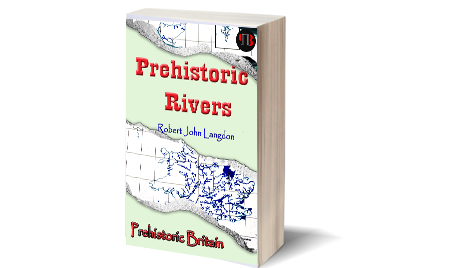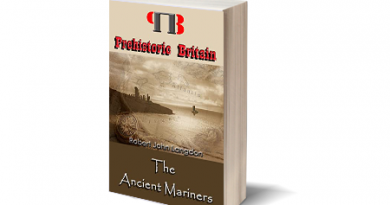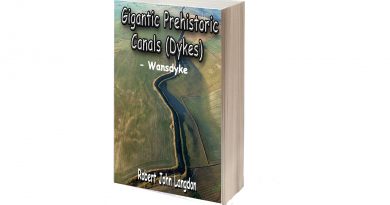Prehistoric Rivers
This mini-book series (shorts) was created especially for the e-book/Kindle and (under a fiver) print market which is growing at a phenom¬enal rate and replacing the conventional book publishing. (Prehistoric Rivers)
The aim of these `bite-sized’ books is to give the reader a small taster of ‘Topics’ from the Epic Trilogy – Prehistoric Britain sold at a reduced price.
These Bite-Sized booklets will include not only new research and photo/diagrams – but also LINKS to exclusive AUDIO and VIDEO media which are not included in the main book.
It is my hope that if you find the subject matter so interesting that you will be compelled to either read the full Trilogy and Documentary available printed textbooks.
Contents
Preface – 7
Introduction – 8
- The Last Ice Age – Not Included
- Hydrology
- Groundwater and Aquifers – Not Included
- The Maths – Not Included
- Precipitation – Not Included
- Sea-Level Changes – Not Included
- Rivers and Streams – Not Included
- The Eurasia Ice Cap – Not Included
- Landscape Transformation – Not Included
- North American Post-Glacial Flooding – Not Included
- Case Study – Mississippi River – Not Included
- Black Sea Post-Glacial Flooding – Not Included
- Germany’s Post-Glacial Flooding – Not Included
- Britain’s Post-Glacial flooding – Included
- Case Study – The Thames – Included
- Case Study River Avon – Included
- Peat – Ultimate Evidence of Holocene Flooding – Not Included
- Case Study – Upper Dee – Not Included
- Case Study – Somerset Plain – Not Included
- Porlock Bay – Not Included
- Minehead Bay – Not Included
- Parrott Valley – Not Included
- Shapwick – Not Included
- Glastonbury – Not Included
- Somerset Levels and Moors – Not Included
- River Siger – Not Included
- Holocene Rivers in Britain – Not Included
- Case Study – Welsh River Catchment – Not Included
- Caersws – Not Included
- Roundabout – Not Included
- Ystrad Caron – Not Included
- Pant – Not Included
- Conclusion
- Appendixes
- Author’s Biography
This is a sample chapter (mini book) from the Second book in Robert John Langdon’s epic Trilogy – Prehistoric Britain (The Stonehenge Enigma).
Twelve thousand years ago, according to our written history, the glaciers from the last Ice Age finally melted away, revealing the Britain we know today? OR DID IT? Britain had been under TWO MILES of ice and the seas that now surround us were frozen solid, leaving a huge mass of enormous weight pushing down on our tiny island. This mass had compressed the land so much that the surface sat some half a mile below the current sea level.
SO WHAT REALLY HAPPENED AFTER THE ICE MELTED?
In this book Robert John Langdon explores the probability that when the ice melted, rather than leaving the land mass we now know as Britain it did, in fact, leave a collection of smaller islands and peninsulas caused by river flooding as the ground water table had risen by just 30m higher than today, creating an aquatic tropical landscape. Quite remarkably, this book shows that Stone Age Man survived the Ice Age and the great flood to go on to develop into a great maritime Civilisation – to date, this unknown society which lived in boats on the waterways and used them to construction our magnificent stone monuments, such as Stonehenge and Avebury that have lasted nearly 10,000 years.
Revisiting accepted Archaeological, Geological and Topological findings Langdon has been able to write an astonishing hypothesis with compelling new proven evidence that not only rewrites our view of prehistoric Britain but consequently, our view of the ancient world! The conclusion of this book indicates that these ‘Megalithic Builders’ are written about in Plato’s works and are described by the Ancient Greeks as ‘hyperboreans’ or who lived accordingly in Doggerland at a place known to Plato as Atlantis.
For more information about British Prehistory and other articles/books, go to our BLOG WEBSITE for daily updates or our VIDEO CHANNEL for interactive media and documentaries. The TRILOGY of books that ‘changed history’ can be found with chapter extracts at DAWN OF THE LOST CIVILISATION, THE STONEHENGE ENIGMA and THE POST-GLACIAL FLOODING HYPOTHESIS. Other associated books are also available such as 13 THINGS THAT DON’T MAKE SENSE IN HISTORY and other ‘short’ budget priced books can be found on our AUTHOR SITE. For active discussion on the findings of the TRILOGY and recent LiDAR investigations that is published on our WEBSITE you can join our FACEBOOK GROUP.

Further Reading
For information about British Prehistory, visit www.prehistoric-britain.co.uk for the most extensive archaeology blogs and investigations collection, including modern LiDAR reports. This site also includes extracts and articles from the Robert John Langdon Trilogy about Britain in the Prehistoric period, including titles such as The Stonehenge Enigma, Dawn of the Lost Civilisation and the ultimate proof of Post Glacial Flooding and the landscape we see today.
Robert John Langdon has also created a YouTube web channel with over 100 investigations and video documentaries to support his classic trilogy (Prehistoric Britain). He has also released a collection of strange coincidences that he calls ‘13 Things that Don’t Make Sense in History’ and his recent discovery of a lost Stone Avenue at Avebury in Wiltshire called ‘Silbury Avenue – the Lost Stone Avenue’.
Langdon has also produced a series of ‘shorts’, which are extracts from his main body of books:
For active discussions on the findings of the TRILOGY and recent LiDAR investigations that are published on our WEBSITE, you can join our and leave a message or join the debate on our Facebook Group.





Pingback: Hollingsbury Camp Brighton - Prehistoric Britain
Pingback: Mesolithic Stonehenge - Prehistoric Britain
Pingback: Stonehenge Hoax – Summer Solstice - Prehistoric Britain
Pingback: The Great Stonehenge Hoax - Prehistoric Britain
Pingback: The Silbury Hill Lighthouse? - Prehistoric Britain
Pingback: Archaeological Pseudoscience - Prehistoric Britain
Pingback: Chapter 3 – Stonehenge Phase II - Prehistoric Britain
Pingback: Section S - NZ16NW - Prehistoric Britain
Pingback: Section V - NZ26NE & NZ26SE - Prehistoric Britain
Pingback: Section I - NY66NW - Prehistoric Britain
Pingback: The Henge and River Relationship - Prehistoric Britain
Pingback: The Great Iron Age Hill Fort Hoax - Prehistoric Britain
Pingback: Ten thousand year old boats found on Northern Europe's Hillsides - Prehistoric Britain
Pingback: Mount Caburn through time - Prehistoric Britain
Pingback: Oswestry through time - Prehistoric Britain
Pingback: Durrington Walls - Woodhenge through time - Prehistoric Britain
Pingback: Alexander the Great sailed into India - where no rivers exist today - Prehistoric Britain
Pingback: Sea Level Changes - Prehistoric Britain
Pingback: On Sunken Lands of the North Sea - lived the World's greatest Civilisation. - Prehistoric Britain
Pingback: The Long Barrow Mystery - Prehistoric Britain
Pingback: TSE DVD Old Sarum - Prehistoric Britain
Pingback: TSE DVD - Avebury - Prehistoric Britain
Pingback: BGS Prehistoric River Map - Prehistoric Britain
Pingback: The Long Barrow Mystery: Unraveling Ancient Connections - Prehistoric Britain
Pingback: Stone transportation and Censorship - Prehistoric Britain
Pingback: Stone Money - Credit System - Prehistoric Britain
Pingback: OSL Chronicles: Questioning Time in the Geological Tale of the Avon Valley - Prehistoric Britain
Pingback: London - The Thames through time - Prehistoric Britain
Pingback: Stonehenge's The Lost Circle Revealed - DEBUNKED - Prehistoric Britain
Pingback: The Stonehenge Enigma - Flipbook - Prehistoric Britain
Pingback: The Great Stonehenge Hoax - Author's Book Listing
Pingback: Dawn of the Lost Civilisation - Author's Book Listing